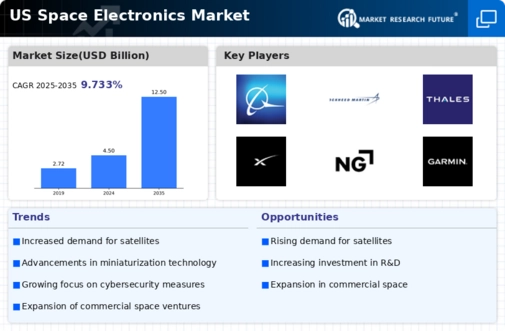Advancements in Satellite Technology
The space electronics market is experiencing a surge due to advancements in satellite technology. Innovations in satellite design and functionality have led to increased demand for sophisticated electronic components. For instance, the market for small satellites, or CubeSats, is projected to grow significantly, with estimates suggesting a value of over $3 billion by 2025. These satellites require high-performance electronics that can withstand harsh space environments, driving the need for specialized components. As the number of satellite launches increases, the space electronics market is likely to expand, with manufacturers focusing on developing lightweight, durable, and efficient electronic systems to meet the evolving requirements of satellite missions.
Emergence of Commercial Space Ventures
The emergence of commercial space ventures is reshaping the landscape of the space electronics market. Companies like SpaceX and Blue Origin are pioneering new business models that prioritize cost efficiency and rapid deployment of space technologies. This shift is driving demand for affordable yet reliable electronic components, as commercial entities seek to optimize their operations. The market for launch services is projected to reach $30 billion by 2030, indicating a robust growth trajectory. As these companies continue to innovate, the space electronics market is likely to benefit from increased orders for advanced electronics that can support a variety of missions, from satellite deployment to interplanetary exploration.
Increased Focus on Space Debris Mitigation
Increased focus on space debris mitigation is emerging as a vital driver for the space electronics market. As the number of satellites in orbit continues to grow, concerns regarding space debris have intensified. Regulatory bodies and space agencies are now prioritizing the development of technologies that can track and manage debris, which necessitates advanced electronic systems. The market for debris mitigation technologies is projected to grow, with investments in sensors and tracking systems expected to rise. This trend indicates a potential expansion of the space electronics market, as companies innovate to create solutions that enhance the safety and sustainability of space operations.
Government Investments in Space Exploration
Government investments in space exploration are a critical driver for the space electronics market. The U.S. government has committed substantial funding to various space initiatives, including NASA's Artemis program, which aims to return humans to the Moon by 2024. This initiative alone is expected to allocate billions of dollars towards developing advanced electronic systems for spacecraft and lunar landers. Additionally, the establishment of the Space Force has further emphasized the importance of space technology, leading to increased procurement of electronic components for defense applications. Such investments are likely to stimulate growth in the space electronics market, as contractors and suppliers respond to the heightened demand for innovative solutions.
Growing Demand for Earth Observation Systems
The growing demand for Earth observation systems is significantly impacting the space electronics market. As climate change and environmental monitoring become pressing global issues, the need for advanced satellite systems equipped with high-quality electronic components is on the rise. The market for Earth observation satellites is expected to exceed $10 billion by 2025, driven by applications in agriculture, forestry, and disaster management. These systems require sophisticated electronics capable of processing large amounts of data in real-time, thus propelling the space electronics market forward. Manufacturers are likely to focus on developing innovative solutions that enhance the capabilities of these observation systems.

















Leave a Comment